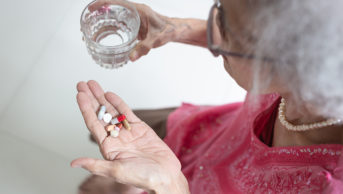This content was published in 2011. We do not recommend that you take any clinical decisions based on this information without first ensuring you have checked the latest guidance.
Key points
- Non-drug management options should be considered first-line for behavioural and psychological symptoms of dementia;
- Use of antipsychotics in dementia is linked to increased mortality and morbidity;
- Those with dementia who develop non-cognitive symptoms or behaviour that challenges should only be offered a pharmacological intervention in the first instance if they are severely distressed or there is an immediate risk of harm;
- Mental health pharmacists can reduce unnecessary prescribing through case review, attending consultant psychiatrist visits and training nursing staff on the benefits and risks of antipsychotic drugs.
The use of antipsychotics to manage behavioural and psychological symptoms of dementia (BPSD) remains a controversial issue in health and social care.
About 180,000 people with dementia are prescribed an antipsychotic each year across the UK but of those only one fifth show any benefit. More importantly, use of these medicines is associated with increased mortality and morbidity, resulting in an estimated additional 1,800 deaths and 1,620 cerebrovascular accidents each year[1].
Indeed, older people are more susceptible to adverse effects associated with antipsychotics such as sedation, hypotension, extrapyramidal side effects and an exacerbation of cognitive decline — the core feature of dementia.
However, the reasons for the overuse of antipsychotics are complex and reflect a system under-equipped to meet the current challenges of dementia care, much of which have been addressed in “Living well with dementia — a National Dementia Strategy”, published in 2009[2].
BPSD, such as agitation and aggression, can be distressing to both patients and carers, and in some cases there may be a risk of harm if symptoms are not managed effectively. Use of antipsychotics in these circumstances has been described as “chemical restraint” and viewed by some as having no place in the care of older people, while others argue that their use may be justified using a palliative care model, with the aim of reducing severe distress in those with reduced life expectancy.
The current National Institute for Health and Clinical Excellence (NICE) guidelines state that those with dementia “who develop non-cognitive symptoms or behaviour that challenges should be offered a pharmacological intervention in the first instance only if they are severely distressed or there is an immediate risk of harm to the person or others” (see Panel 1)[5].
Non-drug management options, tailored to the individual, should be considered first-line following a comprehensive assessment, including identification of underlying causes such as pain or infection.
Panel 1: Antipsychotics used in dementia
No specific antipsychotic has been advocated for the management of
severe behavioural and psychological symptoms of dementia, but
atypical antipsychotics are often used in preference to the typical antipsychotics, consistent with recent recommendations [1].
Some of the commonly prescribed atypical antipsychotics include amisulpride, olanzapine, quetiapine and risperidone.
In most circumstances, prescribing of these medicines is off-label, with the exception of risperidone which is licensed for the short-term treatment (up to six weeks) of persistent aggression in patients with moderate to severe Alzheimer’s dementia unresponsive to nonpharmacological approaches and when there is a risk of harm to self or others.
Medication in care homes
Of particular concern is the use of antipsychotics in care homes, where over
a third of dementia sufferers live[1].
Prescribing of these drugs may have been initiated and maintained by a GP, with little support and input from specialist mental health services. However, prescribing might also have been started within acute hospital services. Often, the rationale for prescribing and subsequent plan for review, reduction or cessation is poorly documented and undertaken.
Although specialist mental health services are generally considered to use antipsychotics more judiciously, there still is often inadequate follow-up.
An independent report, “The use of antipsychotic medication for people with dementia: time for action”, commissioned by the Department of Health, highlighted the need for specialist older people’s mental health services input into care homes and the role of the pharmacist to ensure that good practice recommendations are implemented[1].
In addition, pharmacist-led interventions and input into the multidisciplinary team have been shown to reduce the inappropriate use of medicines in care homes, including antipsychotics.
Key good practice recommendations for antipsychotics include:
- Using the lowest possible effective dose, for the shortest possible time (ideally less than 12 weeks);
- Reviewing at least monthly, and actively considering reduction or cessation (because there is a high rate of spontaneous recovery).
In the UK, a two-third reduction in antipsychotic prescribing from its current level has been recommended as a realistic target over three years[1].
Our aim was to pilot a new service involving pharmacist review of current antipsychotic prescriptions for residents with dementia in a nursing home. The home selected provides continuing care for frail older people, and includes a 22-bed unit for those with advanced dementia.
The clinical pharmacy services are provided by the local mental health trust. The unit has, in the past, been visited twice a week by a newly qualified rotational pharmacist and supervised by a specialist mental health pharmacist. However, there was no formal pharmacy role for reviewing antipsychotic prescribing.
A GP visits once a week and a consultant psychiatrist fortnightly. It was identified that much of the feedback on residents’ behavioural symptoms was based on reports from a single nurse on duty at the time of the psychiatrist’s visit and there was often reluctance for medicines to be stopped. The rest of the multidisciplinary team was usually not involved in the decision making.
The pharmacist or GP did not visit the unit at the same time as the psychiatrist. There was also a lack of formal documentation outlining target symptoms and efficacy of medication. Furthermore, there was a feeling among nursing staff and healthcare assistants that they had a lack of knowledge as to the risks and benefits of using antipsychotics to manage BPSD.
However, training in non-pharmacological interventions to deal with BPSD (see Panel 2 for examples) had recently been provided to the unit by the Admiral Nursing Service.
Panel 2: Non-drug approaches to BPSD[5]
Minimising the risk of behavioural andpsychological symptoms of dementia, such as agitation and aggression, can be achieved by identifying and addressing factors that might contribute to their development.
In care homes, these can include: poor staffing levels, poor communication between staff and dementia sufferer, overcrowding, lack of privacy and lack of activities.
Non-pharmacological interventions should be considered, based on factors such as the individual’s preference, target symptoms, degree of cognitive impairment as well as local availability. Their efficacy should be monitored and adapted as necessary.
Possible approaches include:
- Animal-assisted therapy;
- Aromatherapy;
- Art, music or dance therapy;
- De-escalation techniques (eg, showing empathy, acknowledging concerns and adopting a non-threatening body posture);
- Exercise;
- Massage;
- Multisensory stimulation (also known as Snoezelen; stimuli [eg, lighting effects, sounds or scents] are used to create a soothing and stimulating environment);
- Reminiscence therapy (discussion of past events, usually involving prompts such as photographs and familiar items or music).
Pharmacist-led review
A prescription chart audit identified that 41 per cent (n=9) of residents were prescribed anantipsychotic. It was agreed that the specialist mental health pharmacist would conduct the reviews. A specific tool was designed to collect information, including:
- Dementia diagnosis and any other relevant psychiatric history;
- Mini-mental state examination (MMSE);
- Medical history (including cardiovascular risk factors);
- Current medication plus any previous drugs used for BPSD and response to them;
- Description of target BPSD (including history, severity and frequency);
- Previous and current non-drug approaches.
Over six months the specialist pharmacist performed the reviews — each taking about 30 minutes — and then sought views of the GP and a range of nursing staff on patients’ symptoms. During the pilot, the pharmacist and a member of the nursing staff joined the fortnightly consultant psychiatrist visit, sharing review findings so a better informed and multidisciplinary decision could be made about the best way forward.
The pharmacist also gave a one hour session to nursing staff and health care assistants on the pharmacological management of BPSD, highlighting the benefits and risks of antipsychotic medication, and other pharmacological options such as antidepressants and carbamazepine.
Panel 3: Case study
A resident in her late eighties, with a diagnosis of vascular dementia was transferred to the nursing home following acute hospital admission.
Psychiatric medication at admission was quetiapine 25mg bd and dosulepin 75mg od. Other medicines included amlodipine 10mg od, aspirin 75mg od, atenolol 50mg od, Calcichew D3 ii od and simvastatin 80mg nocte.
She had a history of falls, incontinence and cardiovascular risk factors, including hypertension and hypercholesterolaemia. Quetiapine had been initiated during the hospital stay, where the dominant symptoms were agitation and disinhibited behaviour (eg, removing clothes on the open ward daily). No information was documented about efficacy, if any. The GP noted that the resident was “relatively settled, sometimes takes clothes off”.
A member of the nursing staff noted “does not strip off her clothes so much as before. I notice that she does this when she wants to use the toilet”. During the consultant psychiatrist’s visit, the possible trigger for the resident removing her clothes was discussed and a management plan, including staff ensuring appropriate toileting at regular intervals, agreed around this.
A dose reduction of the quetiapine to 25mg daily was made, with a plan to review at the next visit. After two weeks there had been no deterioration and although the resident continued to remove her clothes, this behaviour was manageable. The quetiapine was subsequently stopped.
Continued monitoring of the target symptoms showed no deterioration. When undertaking the review, the pharmacist also identified that there was no history of depression and queried the prescription of dosulepin. This was found to be due to a medicines reconciliation error during the acute hospital admission.
Outcome
During the pilot, antipsychotic prescribing fell to 9 per cent (n=2). Three of the residents (for whom medication was stopped) had had their antipsychotic prescribing started during acute hospital admissions, in which they were reported to be “aggressive” and “shouting out”. It was also found that three other residents’ challenging behaviour occurred when they were being assisted with personal care (see Panel 3 for a case study).
Non-drug methods allowed antipsychotic prescribing to be stopped with no subsequent deterioration. The consultant psychiatrist commented that the nursing staff “had become more skilled at managing [patients’] behaviour” and believed this contributed to being able to reduce and stop medication.
Another resident was found to have underlying pain and this was treated. The two residents who remained on antipsychotics (for aggression and psychotic symptoms) had demonstrated ongoing benefit from treatment and a risk versus benefit decision was made (and documented) that they should continue.
The pilot was welcomed by the psychiatrist, GP and nursing staff. Use of the review tool provided more information at the point of decision-making (eg, previous response to treatment) and a wider range of views were considered. The pharmacist also felt more empowered to make recommendations about the use of antipsychotics for BPSD and their discontinuation, and developed a greater rapport with the multidisciplinary team.
The consultant psychiatrist commented: “I found the presence of the pharmacist very useful. They challenged the ongoing use of medication, which we often had not initiated, but the staff felt hesitant to stop. With their support, attention, gathering of background information and ongoing monitoring we were able to significantly reduce the use of antipsychotic medication.”
Key factors to the success of the pilot included the mental health specialism of the pharmacist, the input from the consultant psychiatrist (especially around assessing the nature of the BPSD) and the recent training of nursing staff relating to non-drug approaches.
An area for improvement that was identified following the pilot was that there could have been greater involvement of relatives in the decision-making process, as recommended by NICE.
Given the success of the pilot and the positive feedback, it is intended that the specialist pharmacist will continue attending the consultant psychiatrist’s visit, with an ongoing focus for recommending and reviewing pharmacological treatments for BPSD. An independent prescribing qualification would be advantageous. There may be scope to extend such a service to other nursing and care homes.
References
- 1Banerjee S. The use of antipsychotic medication for people with dementia: Time for action. Psych Rights. 2009.http://psychrights.org/research/digest/nlps/BanerjeeReportOnGeriatricNeurolepticUse.pdf (accessed 10 Mar 2021).
- 2Living well with dementia: A National Dementia Strategy. Department of Health. 2009.https://assets.publishing.service.gov.uk/government/uploads/system/uploads/attachment_data/file/168220/dh_094051.pdf (accessed 10 Mar 2021).


